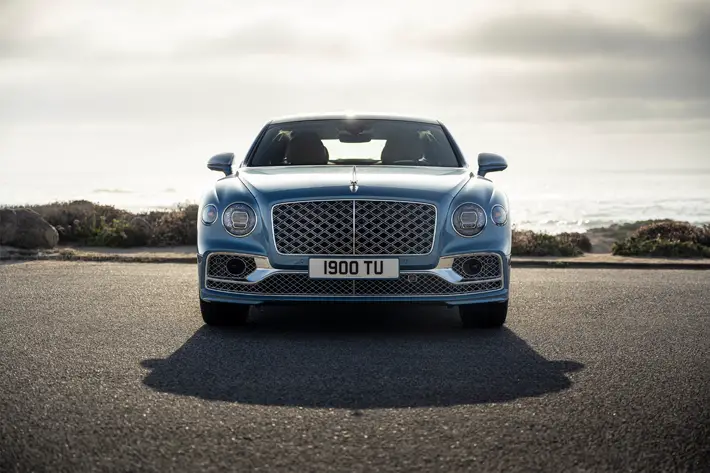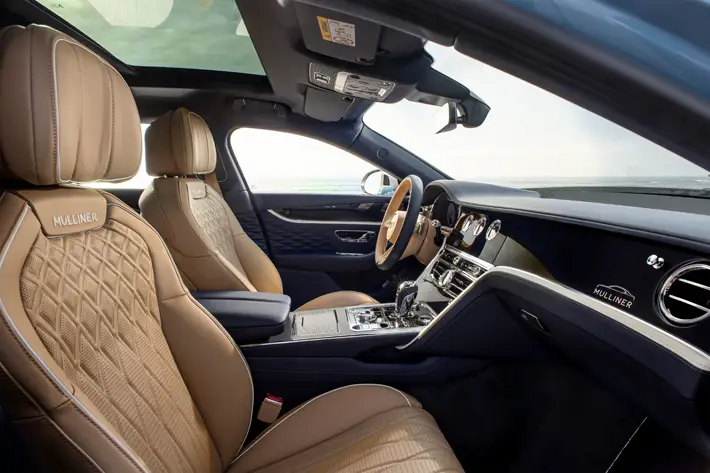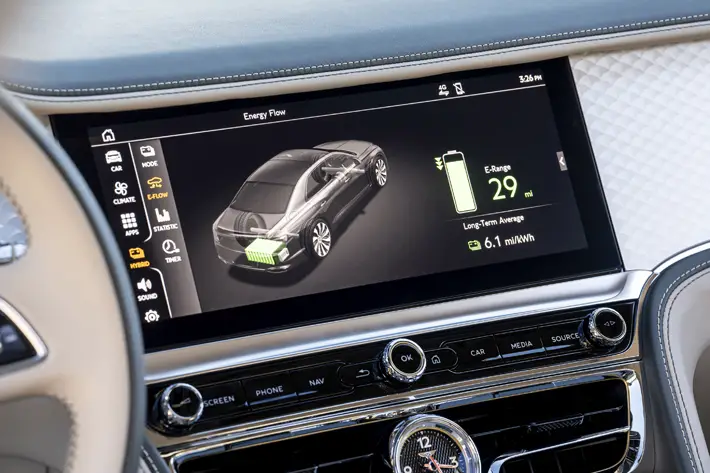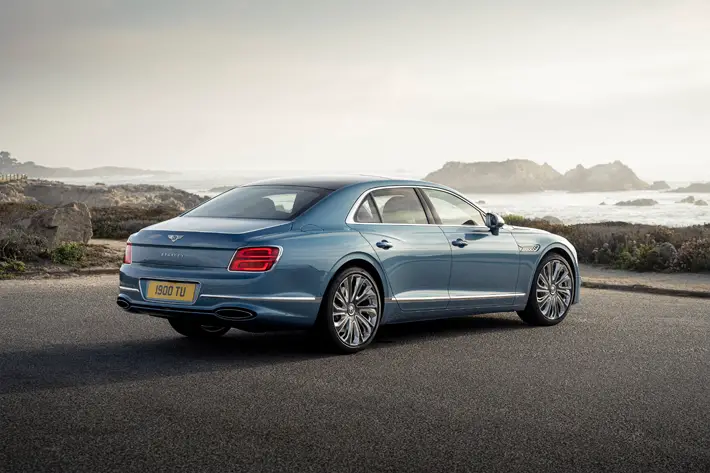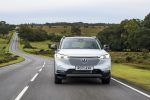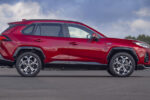Bentley Flying Spur Mulliner Hybrid – Review
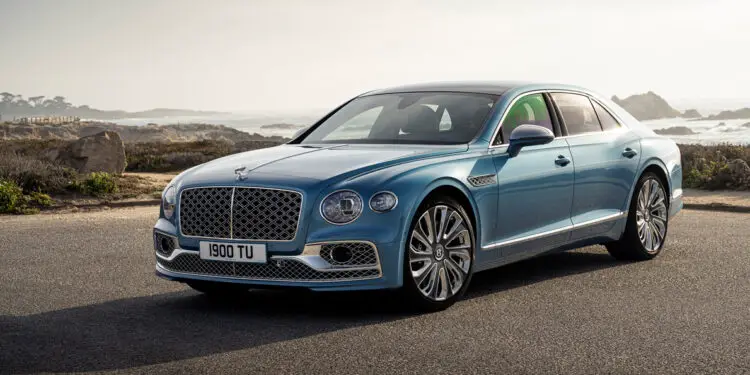
By Liam Bird
There’s a large knurled aluminium knob that sits in the right in the middle of the centre console of a Bentley Flying Spur. In its centre there’s a little black button with the word ‘start’ on it. Pressing said little black button is part of the theatre of driving a Bentley. There’s a slight pause, then there’s the whirring of the starter motor, and then, usually, a hand-assembled, multi-cylindered work of engineering art ignites the first of many gulps of petrol before bursting into life.
Regardless of how young or old you may are, or how many times you’ve done it before, pressing that little black start button and hearing the deep baritone exhaust note that follows doing-so, always feels special.
Or at least, it used to.
“Four-wheeled and luxurious”
Press the very same start button in a Bentley Flying Spur Hybrid and there’s isn’t any noise; no whir of the starter, no ignition, no comforting woofle from the exhaust. Were it not for the digital dashboard coming to life and the faint whir of the air-conditioning fan you could be forgiven for thinking you hadn’t started anything at all. Once you’ve eased the Flying Spur Hybrid’s selector back in to Drive, your progress is on electric power alone. It’s the same when you park: the Hybrid system utilises the battery and motor, not the internal combustion engine.
Bentley know their future will be electric – it has to be. The Crewe-based manufacturer of all things four-wheeled and luxurious plans to have an electrified version of every model in its line-up by 2024, with the first full electric vehicle due the following year. By 2026, the Bentley’s range will consist exclusively of plug-in variants. Bentley’s Beyond 100 strategy has them striving to be a pure-electric car maker by the end of the decade
I know, all of those wonderful engines, all of that history, all of that know-how, just cast aside…
“Kicks in seamlessly”
Personal engineering preferences aside, what can’t be quibbled over is just how smooth a Bentley running solely on electric feels. With the 14.1kWh fully charged – it takes about 2.5 hours from a standard wallbox-type charger – you get up to 25 miles (or perhaps slightly more) of near silent waft; enough to get you across town emissions free. Alternatively, enter your destination into the sat-nav and the Flying Spur Hybrid’s software will calculate whether to extract power from the 134bhp motor right away or use a combination of both the petrol engine and the electric motor whilst simultaneously keeping enough charge stored in the battery to allow you can creep silently through the streets at the end of the journey. It’s all very clever.
But for this kind money perhaps it should be. When the battery’s spent or you’ve decided to hold its charge for later, and the electric motor isn’t in use, the engine kicks in (or out, as the case may be) as seamlessly as you expect it to.
Ah yes, the engine. Beneath that huge bonnet The Flying Spur Hybrid hides a twin-turbo 2.9-litre V6 – as opposed to the Bentley Bentayga’s single-turbo 3.0 V6 – coupled to to a seven-speed DCT transmission rather than an eight-speed auto as found in the SUV. When both motor and engine are spinning total outputs are 536bhp and 553lb ft.
“Dialed-down”
Needless to say then, despite its 2.5 tonne kerbweight, the Flying Spur Hybrid is somewhat swift: the 0-62mph benchmark is dispatched in a little over 4 seconds dead. However, the extra weight of both battery and motor does make itself felt come cornering time. All Bentleys are heavy, but the Flying Spur Hybrid feels as if its handling edge has been blunted. The steering is a tad numb, the usual athleticism somewhat dialed-down; the changes of direction that little bit slower. As a well-respected fellow motor-noter commented “It’s a car probably best enjoyed from the back seat”.
He may be right, everyone I chauffeured said the ride was superb, whereas upfront, I was searching for a little more involvement, a little more connection. As lovely as the Flying Spur Hybrid is to drive, I’m not entirely sure, as someone who likes to drive, I’d call it enjoyable.
Perhaps the satisfaction comes instead from knowing that the Flying Spur Hybrid is capable of real-world low 30s mpg (The V8 Flying Spur won’t better 19), and because it’s a hybrid, it’s entitled to significant tax breaks too (what is it about the rich and tax breaks?). If you pay one, running the plug-in Flying Spur could as much as halve your annual Benefit-in-Kind tax bill. There’s also the fact that wherever you’re sat in a Flying Spur you’re sat in undoubtedly one the finest automotive interiors money can buy. The scent of the beautifully soft leather, all 15 or more carefully selected Scandinavian hides worth of it, genuinely is to die for.
“Something’s missing”
As beautifully built, engineered, and crafted as the Flying Spur Hybrid is, personally, I can’t help but feel that it feels as if something’s missing. I know this is the future, I know we should embrace it, but even it does cost more to run, a V8 Flying Spur feels lighter, handles better and, costs less to buy in the first place.
Call me old-fashioned, but I know which one I’d rather start in the morning.
Bentley Flying Spur Mulliner Hybrid
Engine: 2.9-litre V6 petrol, plus electric motor
Transmission: 8-speed ZF dual-clutch auto, with paddle shift and active all-wheel drive.
Power: 537 bhp @ 5,500-6,500rpm
Torque: 406 lb-ft @ 2,000-5,000rpm
0-60 MPH: 4.1 Sec
Max Speed: 177 mph
CO2: 75 g/km
MPG: 85.6 (WLTP combined)
Battery: 18kWh
Range: 25.5 miles
Kerb weight: 2,512kg
Price: from £233,400 (as driven: £236,155)
